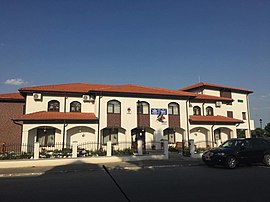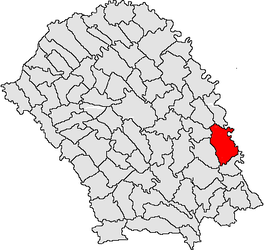Ștefănești, Botoșani
This article needs additional citations for verification. (January 2011) |
Ștefănești | |
|---|---|
 Ștefănești Town Hall | |
 Coat of arms | |
 Location in Botoșani County | |
 Ștefănești Location in Romania | |
| Coordinates: 47°47′29″N 27°11′57″E / 47.79139°N 27.19917°ECoordinates: 47°47′29″N 27°11′57″E / 47.79139°N 27.19917°E | |
| Country | Romania |
| County | Botoșani |
| Government | |
| • Mayor (2020–2024) | Florin Buțura[1] (PNL) |
| Elevation | 67 m (220 ft) |
| Population (2011)[2] | 5,314 |
| Time zone | EET/EEST (UTC+2/+3) |
| Postal code | 717385 |
| Vehicle reg. | BT |
Ștefănești (Yiddish: שטעפנשט, Hebrew: שטפנשט) is a small town in Botoșani County, Western Moldavia, Romania. It administers four villages: Bădiuți, Bobulești, Stânca and Ștefănești-Sat.
The town is located near where the Bașeu River discharges into the Prut River, on the shore of the Stânca-Costești reservoir. Stânca is a border checkpoint with Moldova, connected via the Stânca-Costești Dam to the town of Costești, Moldova.
Demographics[]
According to the census from 2011 there was a total population of 5,092 people living in this town. Of this population, 90.57% are ethnic Romanians, 9.3% ethnic Romani.[3]
Natives[]
The painter Ștefan Luchian (1868–1916) was born here, as well as Vlad Onicescu, the father of the mathematician Octav Onicescu (1892–1983). The town is also the birthplace of the Shtefanesht Hasidic dynasty and as such its name is still known in present-day Israel.
References[]
| Wikimedia Commons has media related to Ștefănești, Botoșani. |
- ^ "Results of the 2020 local elections". Central Electoral Bureau. Retrieved 6 June 2021.
- ^ "Populaţia stabilă pe judeţe, municipii, oraşe şi localităti componenete la RPL_2011" (in Romanian). National Institute of Statistics. Retrieved 4 February 2014.
- ^ "Structura Etno-demografică a României". Edrc.ro. Retrieved 8 October 2017.


- Populated places in Botoșani County
- Localities in Western Moldavia
- Towns in Romania
- Moldova–Romania border crossings
- Populated places on the Prut
- Jewish communities in Romania
- Botoșani County geography stubs

